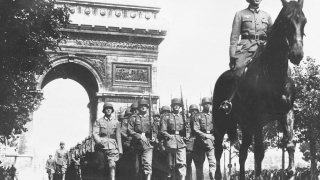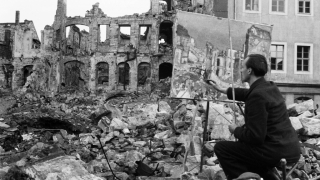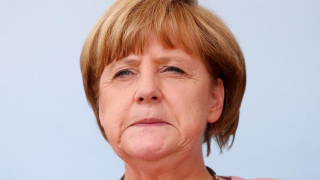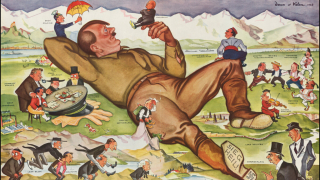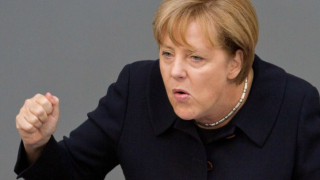75 years ago: Nazi Germany lies in debris and how the Wehrmacht's ultimate defeat was caused
Three-quarters of a century ago the Third Reich lay in ruins, its ruler Adolf Hitler dead, having shot himself in the right temple with his 7.65mm pistol on 30 April 1945. Hitler had refused to leave Berlin over previous days, knowingly sealing his fate. An escape southwards to Bavaria was still possible in the final hours, or to farther flung destinations.
Hitler's personal pilot Hans Baur recalled that on 29 April 1945, “I tried to persuade him that there were still planes available, and that I could get him away to Japan or the Argentine, or to one of the Sheikhs, who were all very friendly to him on account of his attitude to the Jews”. (1)
Baur's offer was not taken seriously by Hitler, who saw the historical importance of remaining in the German capital. Furthermore, by April 29th Hitler's personal bodyguard, the SS Leibstandarte, was preparing to engage the Soviet Army from their headquarters in the Reich Chancellory, positioned beside the Führerbunker.
Today it is not well known that the Red Army, in mid-February 1943, came close to capturing Hitler in person at the frontline. During this time, Baur had flown the German dictator to the city of Zaporozhye, in south-eastern Ukraine. Zaporozhye is situated less than 200 miles south of Kharkov, where the Third Battle of Kharkov was then starting.
With Hitler having reached the airstrip at Zaporozhye, he had a discussion with the Wehrmacht hierarchy nearby. Hitler's chief valet SS officer Heinz Linge, who was present, recalled that, “While Hitler was in conference with his generals, the airfield where our aircraft were parked came under Russian attack, with the result that part of it was captured. The report came as a shock for us and in confusion, lacking any experience of the front, we waited anxiously to see how Hitler would handle the situation. We had the report passed to him at once. It amazed us to see that he could hardly be bothered with it, this report which had hurled us all into a state of near panic. Issuing a few pithy instructions as to how the problem was to be cleared up, he quietly resumed his conference”. (2)
Had the Soviets been aware of Hitler's presence, they would presumably have attacked with much greater determination, possibly capturing the Nazi leader along with his generals, thereby bringing the war to an early end.
German military figures possessing any sense were aware that, by the mid-1940s, the war had been lost long ago. Not in 1943, nor even in 1942. From a strict military viewpoint the critical mistakes by Hitler and, more broadly the Wehrmacht's top brass, were committed from the beginning of their invasion of the USSR in June 1941. One particularly prominent dignitary, Field Marshal Wilhelm Keitel, had sensed danger months before. He warned Hitler that the unfolding designs for Operation Barbarossa were “too ambitious”, and would place enormous strain on the Nazi war machine (3). With Keitel pouring over the plans for Barbarossa with his monocle in late 1940 and into 1941, he foresaw that the attack would likely not succeed.
Keitel then informed Hitler that he opposed it and offered his resignation, which was rejected. He had expounded his views as a professional soldier, not from any ethical reservations pertaining to the Nazi invasion's planned murderous conduct. Later on Keitel, who was not truly sinister at heart, did enter private despair at the crimes committed in the east, unlike some other German generals. His unquestioned loyalty to Hitler would lead to complicity. Keitel faced the hangman's noose at Nuremberg in 1946 – while others who believed in and strongly supported the mass murders like General Franz Halder, Chief of Staff of the German Army High Command, would not suffer the same demise. Halder, a virulent anti-communist and anti-semite, managed to ingratiate himself with the Americans after the war.
From the start, Hitler's attack on the Soviet Union was spread out over too wide an area: 1,800 miles in breadth no less (4). On 22 June 1941, three million German soldiers would be split up into three different Army Groups. They were supported by about 800,000 men from the armed forces of Romania, Italy, Finland, Hungary and Slovakia. These German-led armies were then stretched unnecessarily across vast expanses of the western and south-western Soviet Union. It was an immediate and glaring error that performed a leading role in the invasion's failure and, with it, the ultimate demise of Nazi Germany.
Simply put, Hitler and most of Germany's military leaders had been too greedy from the start. They did not direct their primary focus towards the most important objective by far: Taking the capital city, Moscow, before the autumn rains and winter snow arrived. The great majority of the Wehrmacht's strength should have been concentrated towards the centre, with a smashing blow aimed at Moscow.
Lieutenant-Colonel Donald J. Goodspeed, the knowledgeable Canadian military historian who had fought in western Europe from 1944, discerned that “Hitler wanted too much and, as a consequence, got nothing. The same fundamental error was repeated again and again”. (5)
Hitler wanted Leningrad, he wanted the Crimea, the Donbas, the Caucasus. Two months into the invasion, a Führer Directive was issued by Hitler on 21 August 1941 reinforcing his strategy, and stating that, “The most important objective to be achieved before the onset of winter is not the occupation of Moscow, but the taking of the Crimea, the industrial and coal region of the Donets Basin and the severing of Russian oil deliveries from the Caucasus area, in the north encirclement of Leningrad and link-up with the Finns”.
Belatedly recognising this strategic error, General Halder wrote that Hitler's above command was “decisive to the outcome of this campaign” (6). When the Führer Directive in question was relayed, it should be mentioned that it was supported by the majority of German military men, including at the end the influential General Heinz Guderian. He caved in when discussing the directive personally with Hitler at the Wolf's Lair in East Prussia, among the presence of many other officers who nodded in agreement when Hitler was speaking.
Hitler failed to realise that to kill off – much like his own a dictatorial regime – one must go for the head and not the tail. The head of Soviet dictator Joseph Stalin was in Moscow, not in the Crimea or the Donets Basin. With Moscow captured and Stalin ousted the Soviet system, which in reality was anything but socialist in nature, would have disintegrated like dust in a sand storm.
Lieutenant-Colonel Goodspeed wrote in his 1977 book The German Wars that, “the bulk of the Red Army had been concentrated in front of Moscow for the defence of the capital. If these Russian armies could be encircled and forced to surrender, the war would be as good as over”. (7)
Even as late as August 1941, a frontal attack on Moscow by the core of the German Army would almost certainly have led to the capital's fall by October. The brutal manner of the invasion would increase Soviet resistance; but even this could have been rendered irrelevant with the early capture of Moscow.
Goodspeed noted from the invasion's outset in June 1941 that, “Quite conceivably, a single great thrust along the Warsaw-Smolensk-Moscow axis might have secured the Russian capital for the Germans by the end of August”. (8)
While it is necessary to highlight Hitler's blunders, one should remember that he first took personal command of forces in the field as late as 19 December 1941. On that date, he appointed himself Commander-in-Chief of the German Army. Up until the early 1940s, Hitler had no experience in a military leadership role, and his knowledge of combat was restricted to the First World War, a very different conflict. Unlike Napoleon or his idol Frederick the Great, Hitler had neither risen through the ranks of a military establishment, nor had he commanded forces in his youth.
When the Soviets struck with a huge counter-attack in early December 1941, which threatened to over-run the static German positions, Hitler did partially redeem himself by ordering the Wehrmacht to stand their ground. The renowned British military historian, Liddell Hart, wrote of the situation in late 1941 that, “In retrospect, it is clear that Hitler's veto on any extensive withdrawal worked out in such a way as to restore the confidence of the German troops, and probably saved them from a widespread collapse”. (9)
As Hart also notes, however, in a broader sense the damage was already done; and yet the Germans had exacted monumental casualties on the Soviets in the first weeks and months of Barbarossa. During the Battle of Bialystok-Minsk, that took place across the Polish-Belarusian frontiers and which concluded on 9 July 1941, the Wehrmacht's Army Group Centre inflicted over 300,000 casualties on the Red Army. Almost 5,000 Soviet tanks were destroyed during this battle, while the Germans lost less than 20,000 men and about 100 panzers.
Another major conflagration took place between the Germans and Soviets starting on 8 July 1941, and that occurred around the city of Smolensk, in western Russia, about 250 miles from Moscow. Despite the Germans being outnumbered in both manpower and tanks, over coming weeks they inflicted almost 750,000 casualties on the Soviets (10). In comparison the Wehrmacht lost about a quarter of a million men. It is difficult to envisage the sheer enormity of these blows, coming in spite of the thinly spread German invasion.
On 23 August 1941, less than 300 miles further south, the Battle for the Ukrainian capital of Kiev was beginning. Hitler had refused to drive on to Moscow following the destruction of Soviet forces around Smolensk – sending a significant proportion of his forces south towards Kiev, a city home to almost 900,000 residents. The Battle for Kiev would drag on for about four weeks, costing precious time, but the spoils for the Wehrmacht were great. In one of the most spectacular encircling movements witnessed in modern warfare, the Germans surrounded Kiev on all sides by 17 September 1941. Over following hours, they captured more than 650,000 Soviet troops in Kiev, a greater disaster relating to manpower than Stalingrad would prove to be for the Germans. (11)
No other country in Europe, and perhaps the world, could have sustained such losses as these apart from the Soviets – who could call upon a supply of ready-made soldiers, from the southern Soviet Union and parts of Eurasia, to eventually patch up their casualty list. Stalin was culpable for the catastrophe at Kiev, having over preceding days repeatedly rebuffed allowing a withdrawal from the city. Hitler would make a similar mistake at Stalingrad over a year later.
At the end of September 1941, Hitler at last directed his attention towards Moscow with the impending start of Operation Typhoon. It was too late, the torrential Russian rain showers were fast approaching and would turn the “roads” into quagmires, a logistical nightmare. Entering October 1941 Army Group Centre, commanded by Field Marshal Fedor von Bock, would lead the assault on Moscow. At this point, they were still positioned around 200 miles from the Russian capital, a considerable distance so late in the year.
Even now, Army Group Centre could have been bolstered in their march to Moscow with forces dispatched southwards from Army Group North. Instead, the latter army was engaged in the pointless, not to mention inhumanely cruel, Siege of Leningrad. The pitfalls of ideology again performed a role here, as Hitler wanted to annihilate the city that bore the name of Lenin, a leading founder of the Soviet state. Leningrad was, at best, of secondary importance to Moscow. Regardless, Hitler was confident that Moscow would soon fall. From 3 October 1941, Army Group Centre was implementing two giant pincer movements around the Russian towns of Vyazma and Bryansk – which in coming days would bag for the Germans more than 650,000 Soviet troops, equivalent to over 80 divisions. (12)
Since the start of fighting on 22 June 1941, the Soviets had lost almost four million men by early October, whereas the Germans had suffered not much more than 500,000 casualties at this stage. Meanwhile, the first snows fell in western Russia on 7 October 1941, especially early. It was a dark presentiment for the Germans, and would prove to be one of the coldest winters in Russian history. The snow was light for now and evolved into heavy rain, turning the landmass into rivers of mud, hampering the German advance.
Despite this, on 8 October 1941 Guderian's 2nd Panzer Army took the Russian city of Oryol, less than 200 miles south-west of Moscow. Four days later, on October 12th, German forces made surprisingly steady ground as they stormed the city of Kaluga, 93 miles south-west of Moscow. Next day the Wehrmacht captured the Russian cities of Rzhev and Kalinin. On 19 October 1941 Mozhaysk fell to the Germans, a town just 60 miles west of Moscow. The following day nearby Borodino was also taken. These latest German successes had sparked a great deal of disarray in Moscow. Some residents of the city, along with a number of Soviet officials and bureaucrats, were fleeing in panic eastwards (13). To dampen the hysteria, Stalin declared a state of siege on October 19th and took ruthless steps to eradicate defeatism. Stalin himself remained in Moscow.
By 24 October 1941 the rains returned with ferocity, massively slowing the Wehrmacht's advance. On October 25th the German assault on Moscow had almost ground to a halt, with the terrain a seething mass of mud, impassable for modern panzers. Ironically, horses were seen moving through the morass beyond the immobile panzers, with the Germans using these animals to dislodge their motorised machinery from the mud.
Hitler's form had been boosted during October 24th, when the German 6th Army captured the USSR's third largest city, Kharkov, in eastern Ukraine, home to nearly a million inhabitants. Even these victories were far from decisive. After a critical three week delay, Army Group Centre's advance on Moscow did not resume until 15 November 1941. The mud had frozen solid and the panzers were able to shift into gear again – but the temperature was sinking towards -20 Celsius, and heavy snow falls were another hindrance. These conditions resulted in frostbite cases among some German troops, who lacked sufficient winter clothing and were shorn of basic medical supplies.
Nevertheless on 22 November 1941, the Wehrmacht took the medieval town of Klin, just over 50 miles north-west of Moscow. The following day, November 23rd, Solnechnogorsk was taken, a town less than 40 miles from Moscow. On November 27th, the German 7th Panzer Division established a bridgehead across the Moscow-Volga Canal, and was fewer than 25 miles from the Kremlin. Also during November 27th, the 2nd SS Panzer Division “Das Reich” captured the town of Istra, less than 25 miles west of Moscow.
On November 30th, the Wehrmacht's 2nd Panzer Division had advanced within 20 miles of Moscow to the north. Over coming hours, the Germans continued to creep forward. By 2 December 1941, SS First Lieutenant Otto Skorzeny, who was in the Das Reich Panzer Division, remembered how, “In the clear weather, I could see the spires of Moscow and the Kremlin in my field glasses” (14). On 2 December 1941, a column of motorcycle units from the 2nd Panzer Division descended upon the town of Khimki, 11 miles north-west of Moscow.
Passing Khimki, the German motorcyclists were soon a mere 10 miles from the Kremlin, and five miles from Moscow's outer suburbs, but they dared not advance further due to a lack of armoured support in the rear. Further south, some forward German elements had actually penetrated the Russian capital's outskirts (15). It is as far as they would get, with much of the Wehrmacht's motorised infantry tied up in the forests encompassing Moscow's outer reaches. In early December the temperatures had dropped lower still, approaching -30 Celsius, freezing the oil in the sumps of panzers and trucks.
On December 5th the Red Army launched their great counteroffensive, and it was now plainly clear that Operation Barbarossa had failed. From a purely military standpoint, in spite of Barbarossa's various flaws, some German troops had indeed reached the edge of Moscow. One can imagine what would have occurred had the attack been focused upon the Russian capital from the beginning, or even as late as August. The veteran world war historian, Jacques R. Pauwels, wrote that, “On the evening of that fateful fifth of December, 1941, the generals of the Wehrmacht’s high command reported to Hitler that, on account of the failure of the Blitzkrieg-strategy, Germany could no longer hope to win the war”. (16)
The Wehrmacht's inability to secure Moscow in 1941 was undoubtedly the turning point of World War II. The Germans would regroup in the summer of 1942 and, despite further huge gains, they lacked the necessary strength to seize the decisive initiative, and were further stymied by a shortage of raw materials.
Notes
1 Jessica Green, “Hitler said 'I'm ending it today', then killed himself in his bunker”, Daily Mail, 3 April 2019, https://www.dailymail.co.uk/news/article-6881389/Hitlers-final-words-revealed-personal-diary-Fuhrers-pilot.html
2 Heinz Linge, With Hitler to the End (Frontline Books, 1 July 2009), p. 177
3 Michael E. Haskew, “The Not-So-Secret Way Hitler Conquered Europe During World War II”, The National Interest, 8 September 2019, https://nationalinterest.org/blog/buzz/not-so-secret-way-hitler-conquered-europe-during-world-war-ii-78766
4 John Graham Royde-Smith, Operation Barbarossa European History, Encyclopaedia Britannica, https://www.britannica.com/event/Operation-Barbarossa
5 Donald J. Goodspeed, The German Wars (Houghton Mifflin; First Edition, 1 Jan. 1977), p. 404
6 Andrew Roberts, The Storm of War, (Allen Lane 1795, 6 Aug. 2009)
7 Goodspeed, The German Wars, p. 396
8 Goodspeed, The German Wars, p. 403
9 Liddell Hart, A History of the Second World War (Pan; Main Market edition, 17 July 2014)
10 Lloyd Clark, Kursk: The Greatest Battle (Headline Review, 24 May 2012)
11 C. Peter Chen, Operation Barbarossa, World War II Database, January 2007, https://ww2db.com/battle_spec.php?battle_id=121
12 Jürgen Matthäus, Jewish Responses To Persecution 1933-1946 (Rowman & Littlefield Publishers, 28 Sept. 2017), p. 275
13 Kenneth R. Whiting, The Development of the Soviet Armed Forces (Air University, 1977), p. 43
14 Otto Skorzeny, My Commando Operations (Schiffer Publishing Ltd., 1 Jan. 1995), p. 112
15 Royde-Smith, Operation Barbarossa, Encyclopaedia Britannica
16 Jacques R. Pauwels, “75 Years Ago, the Battle of Stalingrad”, Global Research, 5 February 2018, https://www.globalresearch.ca/75-years-ago-the-battle-of-stalingrad/5628316



